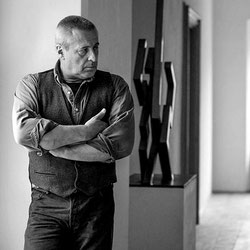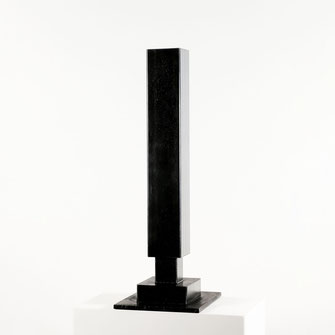SCHAUMBERGER FLORIAN

- 1962 Wien, Österreich
- österreichischer Künstler
- Ausbildung: Akademie der bildenden Künste Wien
- 1962 Vienna, Austria
- austrian artist
- education: Academy of Fine Arts Vienna
Der 1962 geborene Florian Schaumberger lebt und arbeitet im Waldviertel und ist wieder erkennbar durch seine anschaulichen Eisenskulpturen, wie z.B. der Plastik aus Chromnickelstahl, von über 10 Metern Höhe und einer Länge von 12 Metern und einem Gewicht von über 10 Tonnen, die zu den monumentalsten Kunstwerken im öffentlichen Raum der Stadt Wien zählt und am Vorplatz der Österreichischen Nationalbank 1997 errichtet wurde.
„Schaumbergers monumentale Skulptur ist mit Stahl in die Luft gezeichnet. Sie hat eine klar definierte Schauseite, ist nicht rundansichtig. Ihre Ansicht ist das Profil: einem Scherenschnitt gleich. Das polierte Metall reflektiert die Sonne. Das verleiht der an sich schweren Arbeit den Charakter einer Lichtskulptur. Sie wächst von unten nach oben, ohne ihren Kulminationspunkt in luftiger Höhe je zu erreichen. Die vitale Kraft des Futurismus prägt den Grundton der Stahlskulptur: Der aber ist hoch und hell, nicht tief und dunkel."
Dr. Klaus Albrecht Schröder
Florian Schaumberger, born in 1962, lives and works in the region Waldviertel, Lower Austria. His art works are easy to recognize thanks to his vivid iron sculptures. For example, the sculpture of chromium-nickel steel that is 10 meters high, 12 meters long and weighs more than 10 tonnes. The sculpture is one of the most monumental art works in public places from the City of Vienna and was built on the forecourt of the Austrian National Bank in 1997.
According to Albrecht Schröder, director of the Albertina museum, Schaumberger’s sculpture is drawn into the air with steel and is meant to be looked at from a front side but not from all angles. The sculpture’s silhouette with a fragile airiness contrasts with the statics from Holzbauer’s cubic building: closed versus open shape. Polished metal reflects the sun. This gives the massive work a character of a lighting sculpture that grows bottom-up but doesn’t reach its culmination point. The vital power of futurism influences the steel sculpture’s basic colour. However, this basic colour is high and light, but not dark.
Dr. Klaus Albrecht Schröder




